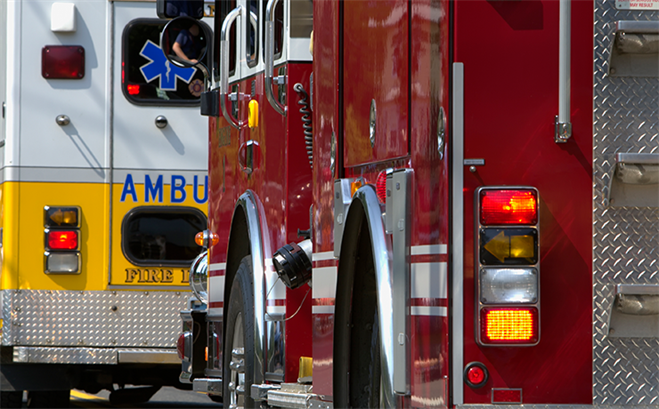Firefighting Over the Decades: Medical vs. Fire Calls
June 03, 2024 by Kate Nadolski

Firefighting and emergency medical services(EMS) — they’re separate jobs, but they go hand in hand. For instance, during a medical emergency, most times dispatch utilizes a response plan that includes sending both fire and EMS to the scene to provide the proper life-saving assistance.
Over the past few decades, there has been a noticeable shift in the type of calls that firefighters respond to. While fire incidents have historically been a significant portion of fire crew’s workloads, the number of fire-related calls has been decreasing steadily due to factors such as improved building codes, fire prevention efforts, and advances in fire suppression and inspection technology.
Meanwhile, the demand for EMS has been on the rise. Medical emergencies, including incidents such as heart attacks, strokes, accidents, and other medical crises, make up a significant portion of the calls for service fire crews respond to across the country. This trend can be attributed to factors such as an aging population, increased awareness of health issues, and the expansion of services provided by fire-based EMS programs.
There’s also speculation that due to the rising cost of health care in the United States, many individuals do not pursue preventive care and only act when their medical condition becomes an emergency, leaving them with minimal options — one of which is calling 911 for help.
According to the National Fire Protection Association (NFPA), the most recent breakdown of fire department calls from 2021 paints a clear picture that supports this trend:
Hazardous material calls: 433,500
Mutual aid calls: 550,000
Other hazardous condition calls: 688,000
*Fire calls: 1,353,500
False alarm calls: 2,904,500
Other: 6,403,500
*Medical calls: 26,291,000
Total calls: 36,624,000
While this trend can be seen in the data going all the way back to the 1980s, the number of medical calls has grown extensively. For example, in 1981 it shows 5,019,000 medical calls made to fire departments in the U.S., compared to the 26,291,000 medical calls to fire departments in 2021 noted above. One explanation is the surge in population in the U.S. over the last several decades, but the population boom only accounts for a fraction of the increase in medical calls.
The day in the life of a firefighter looks much different now than it did 30 years ago, with increasing responsibilities to handle medical emergencies and accidents, rather than just fires.
Below, explore some of the benefits and challenges modern day firefighters face as they continue responding to a larger percentage of medical-related calls.
Challenges of increased medical calls for fire crews:
- Limited Medical Training: While many firefighters receive basic medical training as part of their certification, they may not have the same level of expertise as dedicated EMS professionals. This can pose challenges when dealing with complex medical conditions or advanced life support interventions.
- Resource Allocation: Responding to medical emergencies diverts resources away from fire-related incidents. While fire calls are less prevalent, they can still happen at any time. Fire departments must strike a balance between addressing medical needs and maintaining readiness for firefighting operations, especially in areas with high call volumes.
- Equipment Availability: Fire apparatuses are primarily designed for firefighting purposes, and while they may carry basic medical equipment, they may not have the same range and sophistication as dedicated EMS vehicles. This can limit the scope of medical interventions that firefighters can provide on scene.
- Emotional Toll: Responding to medical emergencies, particularly those involving serious injuries or fatalities, can take a toll on firefighters' mental and emotional well-being. They may encounter traumatic situations that challenge their resilience and require additional support systems.
- Legal and Liability Considerations: Fire personnel providing medical care must adhere to legal and regulatory standards governing emergency medical services. Failure to meet these standards can result in liability issues, emphasizing the importance of ongoing training and adherence to protocols.
Benefits of increased medical calls for fire crews:
- Reduced Response Times: Fire stations are strategically located within communities, allowing for more hands on deck when responding to medical emergencies which can result in quicker response times overall. Rapid intervention can make a crucial difference, particularly in critical situations such as cardiac arrests or traumatic injuries.
- Team Collaboration: Collaborating with EMS personnel fosters teamwork and enhances coordination during emergency responses. Firefighters and EMS personnel can leverage each other's skills and resources to deliver comprehensive care to patients.
- Multiskilled Personnel: Many firefighters are aware of the increasing number of medical calls and will undergo training as emergency medical technicians (EMTs) or paramedics, making them adept at providing immediate medical assistance. Their dual expertise allows for a seamless transition from firefighting to medical care during emergencies.
- Enhanced Community Service: Fire personnel responding to medical emergencies expand their role beyond firefighting, providing essential lifesaving services to the community. This fosters goodwill and strengthens community relations.
Despite the many benefits and challenges modern firefighters face, the integration of fire personnel into medical emergency response teams continues to be a valuable asset in many communities, contributing to more efficient and effective emergency response.